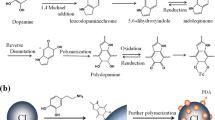Abstract
Synthesis of magnetic polymer particles (MPP) was carried out through two steps. Firstly, the iron oxide particles carrying vinyl groups were synthesized, and in the second step, styrene (ST), divinyl benzene (DVB), and 2-hydroxyethyl methacrylate (HEMA) were polymerized on the surface of modified iron oxide through an emulsifier-free emulsion polymerization technique. The final particles were characterized by a Fourier transform infrared spectroscopy (FTIR), Fourier transform infrared attenuated total reflectance spectroscopy (FTIR-ATR), X-ray diffractometer (XRD), thermal gravimetry analysis (TGA), Fritsch particle sizer, scanning electron microscope (SEM), and vibrating sample magnetometer (VSM). Experimental analysis confirmed that all the iron oxide particles were embedded in a polymer phase and the final particles have more than 67 % iron oxide content. According to magnetometry data, the shape of the hysteresis loops evidences the ferromagnetic character of the particles.








Similar content being viewed by others
References
Sugibayashi K, Morimoto Y, Nadai T, Kato Y (1997) Drug-carrier property of albumin microspheres in chemotherapy. I. Tissue distribution of microsphere-entrapped 5-fluorouracil in mice. Chem Pharm Bull 25:3433–3434
Haik Y, Pai V, Chen CJ (1999) Development of magnetic device for cell separation. J Magn Magn Mater 194:254–261
Setchell CH (1985) Magnetic separations in biotechnology—a review. J Chem Technol Biotechnol B 35:175–182
Shinkai M, Honda H, Kobayashi T (1991) Preparation of fine magnetic particles and application for enzyme immobilization. Biocatalysis 5:61–69
Kondo A, Kamura H, Higashitani K (1994) Development and application of thermo-sensitive magnetic immunomicrospheres for antibody purification. Appl Microbiol Biotechnol 41:99–105
Meza M, Hafeli U, Schutt W, Zborowski M (eds) (1997) Scientific and clinical applications of magnetic carriers. Plenum, New York, p 303
Elaïssari A, Rodrigue M, Meunier F, Herve C (2001) Hydrophilic magnetic latex for nucleic acid extraction, purification and concentration. J Magn Magn Mater 225:127–133
Gupta PK, Hung CT (1989) Magnetically controlled targeted micro-carrier systems. Life Sci 44:175–186
Povey AC, Brouet I, Nixon JR, O′Neill IK (1987) Trapping of chemical carcinogens with magnetic polyethyleneimine microcapsules: III in vivo trapping of electrophiles from N-methyl-N-nitrosourea and recovery from feces. J Pharm Sci 76:201–207
Kronick PL, Campbell GL, Joseph K (1978) Magnetic microspheres prepared by redox polymerization used in a cell separation based on gangliosides. Science 200:1074–1076
Ugelstad J, Kaggerud KH, Hansen FK, Berge A (1979) Absorption of low molecular weight compounds in aqueous dispersions of polymer-oligomer particles, 2. A two step swelling process of polymer particles giving an enormous increase in absorption capacity. Makromol Chem 180:737–744
Ugelstad J, Mork PC, Kaggerud KH, Ellingsen T, Berge A (1980) Swelling of oligomer-polymer particles. New methods of preparation. Adv Colloid Interface Sci 13:101–140
Ugelstad J, Mork PC, Nordhuus I, Mfutakamba H, Soleimany E, Berge A, Ellingsen T, Khan AA (1985) Thermodynamics of swelling. Preparation and application of some composite, monosized polymer particles. Makromol Chem Suppl 10:215–234
Yanase N, Noguchi H, Asakura H et al (1993) Preparation of magnetic latex particles by emulsion polymerization of styrene in the presence of a ferrofluid. J Appl Polym Sci 50:765–776
Noguchi H, Yanase N, Uchida Y et al (1993) Preparation and characterization by thermal analysis of magnetic latex particles. J Appl Polym Sci 48:1539–1547
Kondo A, Kamura H, Higashitani K (1994) Appl Microbiol Biotechnol 41:99
Khng HP, Cunliffe D, Davies S et al (1998) The synthesis of sub-micron magnetic particles and their use for preparative purification of proteins. Biotechnol Bioeng 60:419–424
Margel S, Beitler U (1988) Polyacrolein-type microspheres. US 4:783,336
Meiji T (1987) Manufacture of magnetic microsphere. JP 62204501
Daniel JC, Schuppiser JL, Tricot M (1982) Magnetic polymer latex and preparation process. US 4,358,388
Charmot D, Vidil C (1994) Magnetizable composite microspheres of hydrophobic crosslinked polymer, process for preparing them and their application in biology. US 5,356,713
Joel R, Sophie V (1999) Latex of calibrated monodisperse magnetizable microspheres, process of preparation and use of the said latex in chemistry or in biology. US 5,976,426
Deng Y, Wang L, Yang W, Fu S, Elaı̈ssari A (2003) Preparation of magnetic polymeric particles via inverse microemulsion polymerization process. J Magn Magn Mater 257:69–78
Liu ZL, Ding ZH, Yao KL (2003) Preparation and characterization of polymer-coated core–shell structured magnetic microbeads. J Magn Magn Mater 265:98–105
Candau F, Ottewill RH (1990) An introduction to polymer colloids. Kluwer, The Netherlands
Lovell PA, El-Aasser MS (1997) Emulsion polymerization and emulsion polymers. Wiley, New York
Erdem B, Sudol ED et al (2000) Encapsulation of inorganic particles via miniemulsion polymerization. I. Dispersion of titanium dioxide particles in organic media using OLOA 370 as stabilizer. J Polym Sci Part A 38:4419–4430
Erdem B, Sudol ED et al (2000) Encapsulation of inorganic particles via miniemulsion polymerization. II. Preparation and characterization of styrene miniemulsion droplets containing TiO2 particles. J Polym Sci Part A 38:4431–4440
Erdem B, Sudol ED et al (2000) Encapsulation of inorganic particles via miniemulsion polymerization III characterization of encapsulation. J Polym Sci Part A 38:4441–4450
Gu S, Shiratori T, Konno M (2003) Synthesis of monodisperse, magnetic latex particles with polystyrene core. Colloid Polym Sci 281:1076–1081
Brandrup J, Immergut EH, Grulke EA (1999) Polymer Handbook. Wiley, USA
Author information
Authors and Affiliations
Corresponding author
Rights and permissions
About this article
Cite this article
Baharvand, H. A new method for preparation of magnetic polymer particles. Colloid Polym Sci 292, 3311–3318 (2014). https://doi.org/10.1007/s00396-014-3386-6
Received:
Revised:
Accepted:
Published:
Issue Date:
DOI: https://doi.org/10.1007/s00396-014-3386-6




